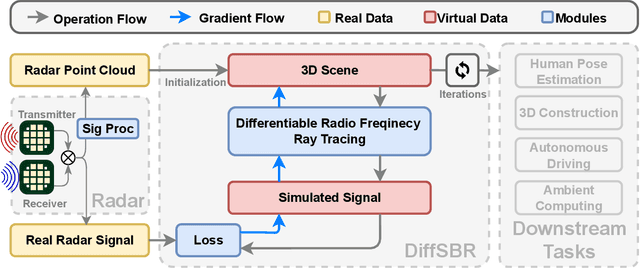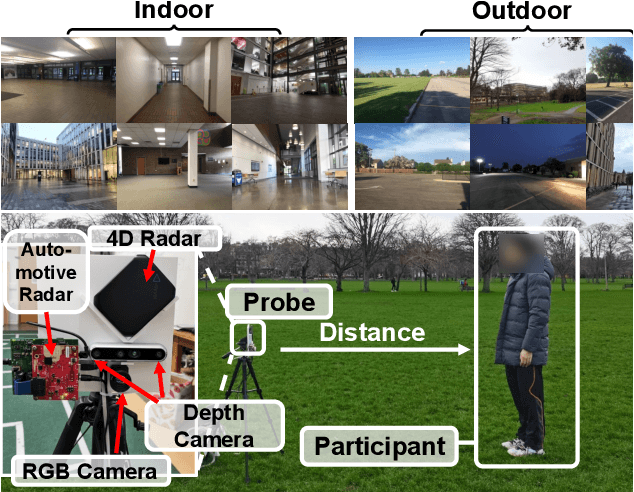Zhengxiong Li
University of Colorado Denver
Bio-Skin: A Cost-Effective Thermostatic Tactile Sensor with Multi-Modal Force and Temperature Detection
Mar 11, 2025Abstract:Tactile sensors can significantly enhance the perception of humanoid robotics systems by providing contact information that facilitates human-like interactions. However, existing commercial tactile sensors focus on improving the resolution and sensitivity of single-modal detection with high-cost components and densely integrated design, incurring complex manufacturing processes and unaffordable prices. In this work, we present Bio-Skin, a cost-effective multi-modal tactile sensor that utilizes single-axis Hall-effect sensors for planar normal force measurement and bar-shape piezo resistors for 2D shear force measurement. A thermistor coupling with a heating wire is integrated into a silicone body to achieve temperature sensation and thermostatic function analogous to human skin. We also present a cross-reference framework to validate the two modalities of the force sensing signal, improving the sensing fidelity in a complex electromagnetic environment. Bio-Skin has a multi-layer design, and each layer is manufactured sequentially and subsequently integrated, thereby offering a fast production pathway. After calibration, Bio-Skin demonstrates performance metrics-including signal-to-range ratio, sampling rate, and measurement range-comparable to current commercial products, with one-tenth of the cost. The sensor's real-world performance is evaluated using an Allegro hand in object grasping tasks, while its temperature regulation functionality was assessed in a material detection task.
Adaptive Anomaly Recovery for Telemanipulation: A Diffusion Model Approach to Vision-Based Tracking
Mar 11, 2025Abstract:Dexterous telemanipulation critically relies on the continuous and stable tracking of the human operator's commands to ensure robust operation. Vison-based tracking methods are widely used but have low stability due to anomalies such as occlusions, inadequate lighting, and loss of sight. Traditional filtering, regression, and interpolation methods are commonly used to compensate for explicit information such as angles and positions. These approaches are restricted to low-dimensional data and often result in information loss compared to the original high-dimensional image and video data. Recent advances in diffusion-based approaches, which can operate on high-dimensional data, have achieved remarkable success in video reconstruction and generation. However, these methods have not been fully explored in continuous control tasks in robotics. This work introduces the Diffusion-Enhanced Telemanipulation (DET) framework, which incorporates the Frame-Difference Detection (FDD) technique to identify and segment anomalies in video streams. These anomalous clips are replaced after reconstruction using diffusion models, ensuring robust telemanipulation performance under challenging visual conditions. We validated this approach in various anomaly scenarios and compared it with the baseline methods. Experiments show that DET achieves an average RMSE reduction of 17.2% compared to the cubic spline and 51.1% compared to FFT-based interpolation for different occlusion durations.
Impact of Tactile Sensor Quantities and Placements on Learning-based Dexterous Manipulation
Sep 30, 2024



Abstract:Tactile information effectively enables faster training and better task performance for learning-based in-hand manipulation. Existing approaches are validated in simulated environments with a large number of tactile sensors. However, attaching such sensors to a real robot hand is not applicable due to high cost and physical limitations. To enable real-world adoption of tactile sensors, this study investigates the impact of tactile sensors, including their varying quantities and placements on robot hands, on the dexterous manipulation task performance and analyzes the importance of each. Through empirically decreasing the sensor quantities, we successfully find an optimized set of tactile sensors (21 sensors) configuration, which keeps over 93% task performance with only 20% sensor quantities compared to the original set (92 sensors) for the block manipulation task, leading to a potential reduction of over 80% in sensor manufacturing and design costs. To transform the empirical results into a generalizable understanding, we build a task performance prediction model with a weighted linear regression algorithm and use it to forecast the task performance with different sensor configurations. To show its generalizability, we verified this model in egg and pen manipulation tasks and achieved an average prediction error of 3.12%.
Bi-directional Momentum-based Haptic Feedback and Control System for Dexterous Telemanipulation
Sep 30, 2024Abstract:Haptic feedback is essential for dexterous telemanipulation that enables operators to control robotic hands remotely with high skill and precision, mimicking a human hand's natural movement and sensation. However, current haptic methods for dexterous telemanipulation cannot support torque feedback, resulting in object rotation and rolling mismatches. The operator must make tedious adjustments in these tasks, leading to delays, reduced situational awareness, and suboptimal task performance. This work presents a Bi-directional Momentum-based Haptic Feedback and Control (Bi-Hap) system for real-time dexterous telemanipulation. Bi-Hap integrates multi-modal sensors to extract human interactive information with the object and share it with the robot's learning-based controller. A Field-Oriented Control (FOC) algorithm is developed to enable the integrated brushless active momentum wheel to generate precise torque and vibrative feedback, bridging the gap between human intent and robotic actions. Different feedback strategies are designed for varying error states to align with the operator's intuition. Extensive experiments with human subjects using a virtual Shadow Dexterous Hand demonstrate the effectiveness of Bi-Hap in enhancing task performance and user confidence. Bi-Hap achieved real-time feedback capability with low command following latency (delay<0.025s) and highly accurate torque feedback (RMSE<0.010 Nm).
Differentiable Radio Frequency Ray Tracing for Millimeter-Wave Sensing
Nov 22, 2023



Abstract:Millimeter wave (mmWave) sensing is an emerging technology with applications in 3D object characterization and environment mapping. However, realizing precise 3D reconstruction from sparse mmWave signals remains challenging. Existing methods rely on data-driven learning, constrained by dataset availability and difficulty in generalization. We propose DiffSBR, a differentiable framework for mmWave-based 3D reconstruction. DiffSBR incorporates a differentiable ray tracing engine to simulate radar point clouds from virtual 3D models. A gradient-based optimizer refines the model parameters to minimize the discrepancy between simulated and real point clouds. Experiments using various radar hardware validate DiffSBR's capability for fine-grained 3D reconstruction, even for novel objects unseen by the radar previously. By integrating physics-based simulation with gradient optimization, DiffSBR transcends the limitations of data-driven approaches and pioneers a new paradigm for mmWave sensing.
A Resource-efficient FIR Filter Design Based on an RAG Improved Algorithm
Oct 02, 2023



Abstract:In modern digital filter chip design, efficient resource utilization is a hot topic. Due to the linear phase characteristics of FIR filters, a pulsed fully parallel structure can be applied to address the problem. To further reduce hardware resource consumption, especially related to multiplication functions, an improved RAG algorithm has been proposed. Filters with different orders and for different algorithms have been compared, and the experimental results show that the improved RAG algorithm excels in terms of logic resource utilization, resource allocation, running speed, and power consumption under various application scenarios. The proposed algorithm introduces a better circuit structure for FIR filters, fully leveraging resource allocation strategies to reduce logic resource consumption. The proposed circuit is faster and more stable, making it suitable for a variety of complex application scenarios.
 Add to Chrome
Add to Chrome Add to Firefox
Add to Firefox Add to Edge
Add to Edge